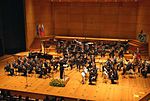National Institute of Chemistry
Education in LjubljanaResearch institutes in Slovenia
The National Institute of Chemistry (in Slovene: Kemijski Inštitut) in Ljubljana is the second largest natural sciences research institute in Slovenia (the country's largest being the Jožef Stefan Institute). Research at the National Institute is divided into two major fields: life sciences and materials science. Among its 11 departments, the Department of Materials Chemistry (D10) is the biggest department in the field of materials science.
Excerpt from the Wikipedia article National Institute of Chemistry (License: CC BY-SA 3.0, Authors).National Institute of Chemistry
Hajdrihova ulica, Ljubljana Rožna dolina
Geographical coordinates (GPS) Address Nearby Places Show on map
Geographical coordinates (GPS)
| Latitude | Longitude |
|---|---|
| N 46.0427 ° | E 14.4936 ° |
Address
Kemijski inštitut
Hajdrihova ulica
1115 Ljubljana, Rožna dolina
Slovenia
Open on Google Maps








